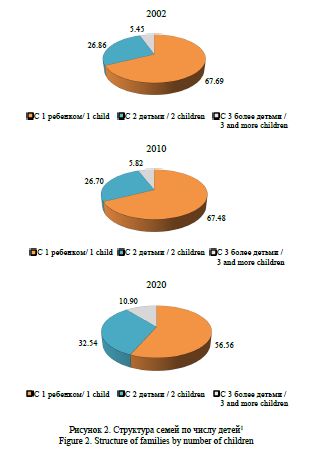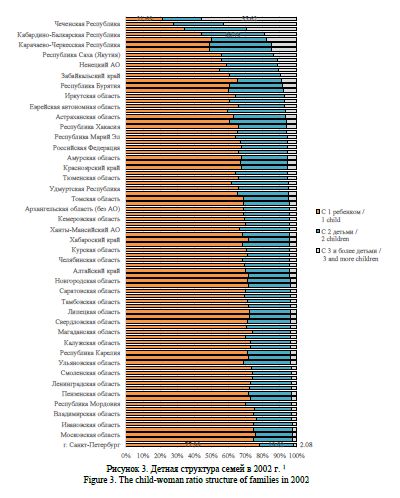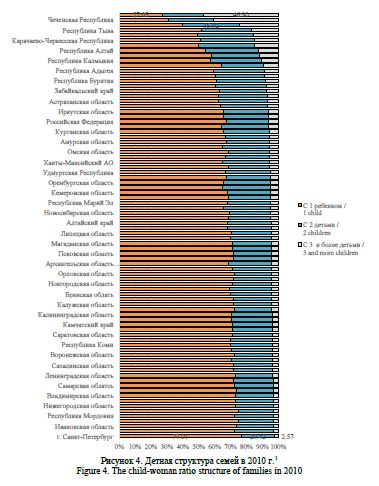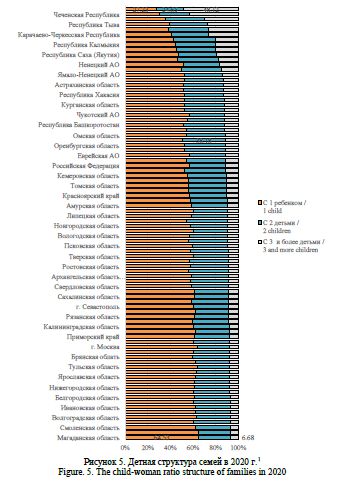The transformation of child-woman ratio in families in modern Russia
The relevance of this issue is connected with the transformation of the child-woman ratio in families and its influence on the socio-economic development of the country. Changes in family structure cause fluctuations in the economic behaviour of the population. New needs, constraints and risks arise. In addition, the transformation of models of the child-woman ratio makes it possible to assess the dynamics of demographic development and the effectiveness of social policy measures. Thus, the results presented can be used by both public authorities and business representatives. The scientific problem was to determine the vector of transformation of the child structure of families in different subjects to identify the regions that are leaders of the demographic development of the country. Methods. This study is based on a statistical analysis of the results of the 2002, 2010 and 2020 All-Russia population censuses. Data on the dynamics of the number of family units in Russia and its regions were used. Comparisons and grouping of subjects were carried out. The results are presented graphically. Research results. The study showed that the intensification of family and demographic policy measures contributed to the formation of a more balanced family structure of Russian families. At the same time, their effectiveness varied in different regions of the country. The effects of state policy could be seen not only in an increase in the number of births of children of the order at which the measures were primarily aimed, but also in the births of children of a higher order. However, the positive effects were not widespread. In a number of regions, the proportion of large families decreased and the popularity of one-child families increased. A regional analysis of the structure of families by number of children allowed us to assess which issues contributed more to the national picture of its transformation. Conclusions. The child structure of families in modern Russia tends to improve in relation to the demographic development of the state. However, the focus of attention is on the regions with traditionally high birth rates, where the proportion of large families and the depth of the child-woman ratio are decreasing.
Figures





Sivoplyasova, S. Yu. (2025), “The transformation of child-woman ratio in families in modern Russia”, Research Result. Sociology and Management, 11 (1), 181-197, DOI: 10.18413/2408-9338-2025-11-1-1-2.


















While nobody left any comments to this publication.
You can be first.
rkhangelsky, V. N., Ivanova, A. E., Rybakovsky, L. L. (2016), Rezultativnost demograficheskoy politiki Rossii [The effectiveness of Russia's demographic policy], Publishing House “Econ-Inform”, Moscow, Russia. (In Russian)
Arkhangelskii, V. N., Smirnov, A. V. (2023), “Influence of value orientations and standard of living in the region on reproductive intentions (based on the results of a study in the Tyumen Oblast)”, Problemy razvitiya territorii, 27 (4), 93-112. (In Russian)
Birkova, S. S. (2019), “The number of children and families with children in Russia”, Sem'i s detmi v Rossii: uroven zhizni i politika sotsialnoy podderzhki: dokl. k XX Apr. mezhdunar. nauch. konf. po problemam razvitiya ekonomiki i obshhestva, Moskva, 9-12 apr. 2019 g. [Family with children in Russia: standard of living and social support policy: dokl. to the XX Apr. international scientific conference on problems of economic and social development, Moscow, 9-12 Apr. 2019], in Ovcharova L. N. (ed.), Publishing House of the Higher School of Economics, Moscow, Russia. (In Russian)
Goncharova, N. P., Eremin, A. A., Tarasova, E. V. (2020), Demograficheskaya politika v sovremennoy Rossii: osobennosti realizatsii i metodika otsenki rezultativnosti [Demographic policy in modern Russia: features of implementation and methods of performance assessment], Direct Media, Moscow, Russia; Berlin, Germany. (In Russian)
Gorshkov, M. K. (2019), “On the social results of post-Soviet transformations”, Sotsiologicheskie issledovaniya, (11), 3-17. (In Russian)
Yelizarov, V. V. (2018), “Target indicators of Russia's demographic development for 2024: will the experience of the recent past help in achieving them?”, Trudy Volnogo Ekonomicheskogo Obshhestva, 211 (3), 322-350. (In Russian)
Karpovich, N. N. (2018), “Dynamics of the socio-demographic situation of large families in Moscow”, Sotsiologiya, (2), 143-149. (In Russian)
Kolbina, E. O. (2023), “Evaluating the impact of the population policy on fertility rates in Russia”, Mir Rossii, 32(3), 75-96. (In Russian)
Kostina, E. Y. (2015), “Social well-being and social security in the context of globalization of modern society”, Universum: obshhestvennye nauki: elektrony nauchny zhurnal, 6 (16), [Online], available at: https://7universum.com/pdf/social/6 (16)/Kostina.pdf (Accessed 2 November 2024). (In Russian)
Kuchmaeva, O. V., Petryakova, O. L. (2011), “Transformation of family structure and demographic behaviour”, Rossiya: tendentsii i perspektivy razvitiya, (6), 226-232. (In Russian)
Lysukho, A. S. (2020), “Review of Russian research on the topic “social well-being”: basic research and results”, INAB, (1), Subiektivnoe i obiektivnoe blagopoluchie v sovremennom rossiyskom obshhestve: rezultaty empiricheskogo issledovaniya [Subjective and objective well-being in modern Russian society: results of an empirical study], 7-17. DOI: 10.19181/INAB.2020.1.1. (In Russian)
Nagibina, N. I., Vakulskaya, E. A., Peshneva, E. O. (2020), “WELFARE. Managing employee well-being to increase labor productivity - improving business indicators of HR and the company”, Upravlenie personalom i intellektualnymi resursami v Rossii, 4(49), 8-17. DOI 10.12737/2305-7807-2020-8-17 (In Russian)
Prokoshneva, L. M., Kupriyanova, E. I. (2009), “A long-term family in Russia”, Weekly “Demoscope”, 373-374, [Online], available at: https://www.demoscope.ru/weekly/2009/0373/tema01.php#_FNR_2 (Accessed 3 November 2024). (In Russian)
Rostovskaya, T. K., Kuchmaeva, O. V., Vasilyeva, E. N. (2024), “Large family in modern Russian society: demographic aspect”, Voprosy upravleniya, 18(3), 9-23. DOI 10.22394/2304-3369-2024-3-9-23. (In Russian)
Sivoplyasova, S. Yu. (2007), “State support for a large family in the context of ensuring economic security in Russia”, Ph.D. Thesis, Stavropol state university, Stavropol, Russia. (In Russian)
Sivoplyasova, S. Yu. (2016), “Regional differences of large families in Russia”, Science. Culture. Society, (2), 132-145. (In Russian)
Dave, C., Sadashivaiah, K. (1981), “Family Size and Quality of Life”, Social Change,
11 (3-4), 35-44.
Behrman, Julia A. (2024), “Ideal Family Size and Reproductive Orientations: An Exploration of Change Over Time in the United States”, Demography, 1 October, 61 (5), 1535-1557.
Rath, T., Harter, J. Well-being: The Five Essential Elements. Gallup Press; (First Printing edition), [Online], available at: https://clck.ru/3GEqba (Accessed 10 October 2024).